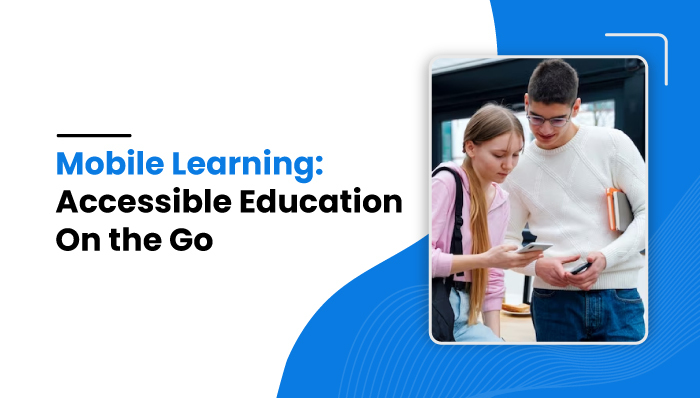Mobile Learning: Accessible Education On the Go

Mobile Learning: Accessible Education On the Go
In a world where technology has become an integral part of everyday life, mobile learning emerges as a powerful tool to democratize education. It provides access to knowledge anytime, anywhere, fostering a learning culture that transcends the traditional boundaries of classrooms and schedules.
Learning Anytime, Anywhere: The Flexibility of Mobile Learning
Mobile learning, often referred to as m-learning, signifies the utilization of mobile technology to facilitate learning. It’s not just about making learning more convenient, but also about making it more personalized, interactive, and accessible. This form of learning allows individuals to engage in educational activities at their own pace and according to their own schedule.
The flexibility of mobile learning is one of its most significant advantages. As the learning materials are available online, they can be accessed at any time and from any location. This means that learners are no longer restricted to a specific time or place for education. Whether they are on a bus, in a park, or at home, they can learn whenever and wherever they want. This flexibility allows learners to integrate their learning activities into their daily lives, making education a continuous and lifelong process.
Moreover, mobile learning is not just about consuming information, but also about interacting with it. With the help of mobile devices, learners can engage with the learning materials, participate in discussions, and collaborate with others. This interactive nature of mobile learning not only makes education more engaging but also more effective, as it encourages active learning and critical thinking.
Mobile Apps for Content Delivery and Interactive Learning
Mobile apps have become a crucial element in the realm of mobile learning. They serve as platforms for delivering educational content and fostering interactive learning. These apps come in various forms, ranging from e-books and online courses to educational games and virtual simulations.
One of the main benefits of mobile apps is that they allow for a more personalized learning experience. They can adapt to the learner’s level of understanding, pace of learning, and learning style. For instance, if a learner is struggling with a particular topic, the app can provide additional resources or exercises to help the learner understand the topic better. On the other hand, if a learner is progressing quickly, the app can offer more challenging materials to keep the learner engaged.
In addition, mobile apps facilitate interactive learning. They provide learners with opportunities to engage with the learning materials, solve problems, and apply what they have learned. Some apps even enable learners to connect with others, allowing them to learn from each other and collaborate on projects. This interactive nature of mobile apps not only makes learning more engaging but also more effective, as it fosters active participation and critical thinking.
Personalized Learning through Mobile Devices: Adapting Education to Individual Needs
Mobile learning opens up a world of possibilities for personalized education. Through mobile devices, educational content can be tailored to meet the individual needs of each learner. This personalized approach to education has the potential to enhance learning outcomes and make learning a more enjoyable and meaningful experience.
Personalized learning is about understanding and catering to the unique needs of each learner. It takes into account the learner’s current level of understanding, learning style, interests, and goals. By adapting the educational content to these factors, mobile learning can provide a learning experience that is more relevant and effective for each individual.
For example, if a learner prefers visual learning, the mobile learning platform can present the information in the form of graphics, videos, or animations. If a learner has a specific interest in a certain topic, the platform can offer resources or activities related to that topic. If a learner aims to achieve a certain goal, the platform can provide guidance and support to help the learner reach that goal.
Overcoming Barriers to Education: Mobile Learning for Underserved Communities
One of the most significant impacts of mobile learning is its potential to overcome barriers to education and make education accessible to underserved communities. By leveraging mobile technology, education can reach individuals and communities that have been traditionally marginalized due to geographical, economic, or social constraints.
In remote or rural areas, where access to quality education is often limited, mobile learning can provide a viable solution. As long as there is a connection to the internet, learners can access educational resources and engage in learning activities, regardless of their geographical location.
Similarly, for individuals who cannot afford traditional education, mobile learning offers a more affordable alternative. The cost of mobile learning is generally lower than that of traditional education, as it eliminates the need for physical infrastructure and reduces the cost of learning materials. Furthermore, many mobile learning resources are available for free or at a very low cost, making education more affordable and accessible.
In conclusion, mobile learning is not just a trend, but a powerful tool that can reshape the landscape of education. By making education more flexible, personalized, interactive, and accessible, it has the potential to democratize education and foster a culture of lifelong learning.
For more information on mobile learning and how it can benefit you, visit https://easyhomework.net/. Experience the transformation that mobile learning can bring to your educational journey.



 WhatsApp Spy
WhatsApp Spy Facebook & Messenger Spy
Facebook & Messenger Spy Viber Spy
Viber Spy Instagram Spy
Instagram Spy Skype Spy
Skype Spy TikTok Spy
TikTok Spy Telegram Spy
Telegram Spy LinkedIn Spy
LinkedIn Spy Twitter Spy
Twitter Spy Youtube Spy
Youtube Spy Photo Spy
Photo Spy Video Spy
Video Spy Calls and Contacts Tracking
Calls and Contacts Tracking SMS & IM Chats
SMS & IM Chats Voice Capture
Voice Capture Image Capture
Image Capture Video Record
Video Record